Weight Training for Climbing 102
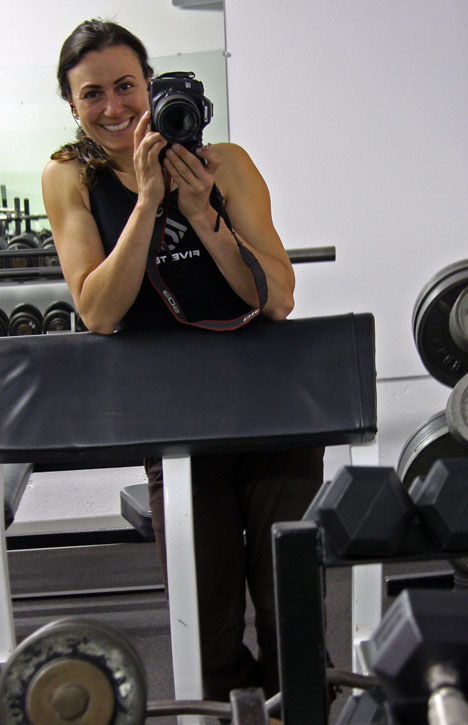
I notice that when I do any sort of training, it does seem to make climbing more fun, so I regularly climb on my wall, do fingerboard workouts, run, do yoga, and lift weights. All these things seem to help with climbing, as well as keeping me active and energetic.
I learned how to lift weights in college. Over the years, I have always enjoyed weight lifting when I am in one place for any length of time. If I do upper body strength training, I become stronger, if I don’t, I become weaker. Being stronger in the upper body makes me climb better. Sold!
Also, I enjoy having some routine in my life. I definitely notice the endorphines and the good feeling I get from an hour lifting weights. Also, having a weight routine already is extremely helpful if you get injured. You can always find SOMEthing you can do in a gym, even if it’s just moving bars around without any added weight, or spinning on a seated bike with no resistance, to keep your blood flowing and to use your muscles a little bit so they don’t atrophy while you are healing. A few of the exercises I do now are things I stumbled upon last time I was really hurt, with torn intercostals in my ribs–they were some of the things that didn’t hurt my rib, so I started doing them, and I liked them so much I incorporated them into my normal, non-injured weight program.
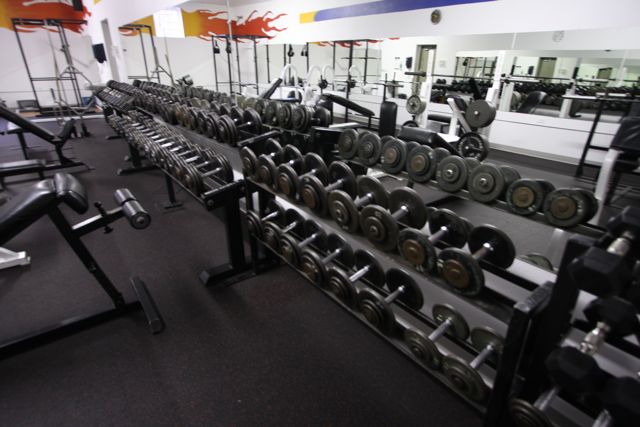
I try to lift weights on a second day on (with climbing outside or on my wall the first day), but often the lifting day is dictated by weather. It’s a lot easier to go into the gym when it’s windy or raining outside.
Luckily for me, Moab has the best weight gym in the world, the Moab Fitness Center! It is open 24 hours, and usually it is empty during the day, or with a few regulars during busy hours. It has every weight machine and piece of iron known to man. I love the Moab Fitness Center. It is so low-traffic, I had to use the mirrors and take all these pictures myself 🙂
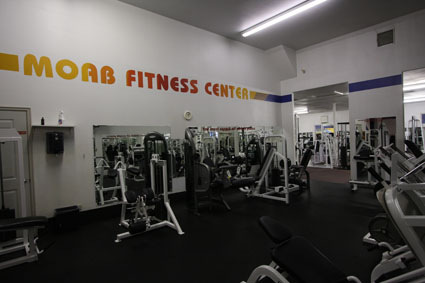
My weight routine is more conceptual than specific. As with everything I do, it is not a precise science, and may or may not be an “official” perfect method, and is always evolving over time. It works for me, and definitely does some good, overall.
Basically, I have picked out some machines/exercises that seem directly related to climbing, and then some which are for the muscles you don’t use as much when climbing. I also do a fair amount of abdominal exercises, at the end of my workout. I don’t do anything for legs, only for the upper body. I get plenty of exercise for leg muscles through hiking and running. Especially being female and not prone to building upper body mass, the muscles I need to keep after are the upper body muscles, which only get used when climbing. I don’t do any pullups in the weight room, because I am doing pullups when I do my fingerboard workout (see “Fingerboard Training 101”).
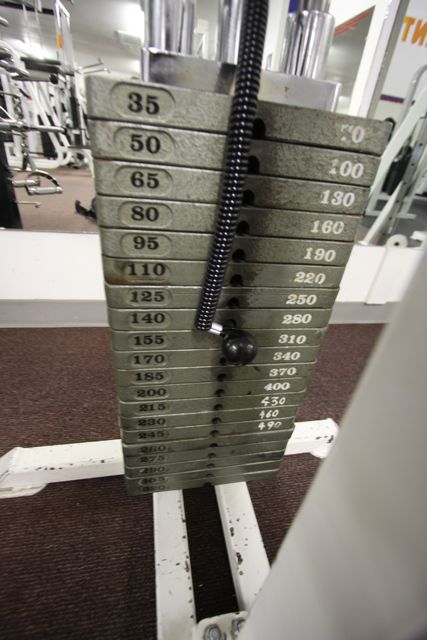
With each exercise I do, I use a pyramid-type (but not literally, because I only go up, so I guess you’d call it more of an ascending ladder) style. I start with a lower weight and do a set of 10. For the next set, I increase the weight by one level, and do a set of 8. For the next set, I increase the weight by another level, and do a set of 6. If the first set of 10 is pretty manageable, and then I can just barely manage to do 6 on the last set, I know I’m in the right weight range.
After a couple of workouts, I raise the reps so the first set is 10 reps, the next is 10, and the last is 8. After another workout or so, when I’ve gotten to doing all three sets at 10 reps, I raise the weights up a level, and do 10, 8, 6 progression, but with everything one weight level higher than I was doing before. In this way, you can always be on a gradual progression, and you never risk overdoing it since warm ups are built into your routine.

When starting the workout, I do a small shoulder warm up routine with dumbbells, same idea: starting with 3 pound dumbbells, next set with 5 pounds, next set with 8 pounds. The warmup goes like this: 10 reps of arms parallel to the floor with elbows bent, raising the forearms up and down to shoulder height, elbows staying in place, 10 reps of straight arm raises on each side, 10 reps of butterflies, 10 reps of shoulder presses. Then repeat this with the next weight (5 pounds for me), then repeat it with the next weight (8 pounds for me). This is a great warm up, but also works the shoulders slightly.
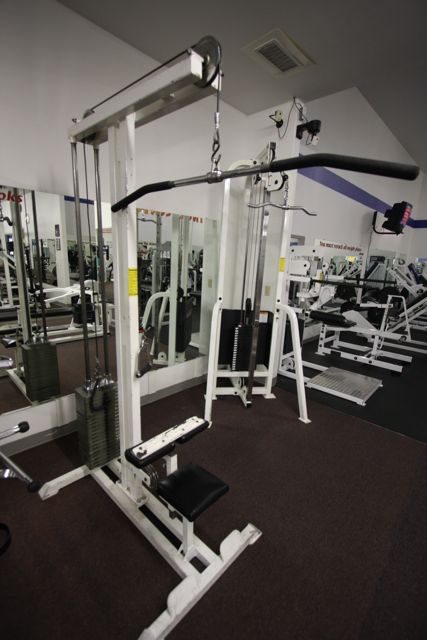
Next, I move to the lat pulldown machine. This is a for-climbing exercise. I start at 65 pounds, and pull the bar in front, all the way to my waist, which is different than a normal lat pull. This seems directly good for climbing. The first set is the set of 10. I like to alternate between two different exercises during these sets, so I leave the lat pull machine and pair it with the shoulder/military press (opposite of climbing muscle exercise). I start at 30 pounds on that machine, and do 10 presses for the first set. I find this exercise really hard, since it is the exact opposite of climbing muscles.
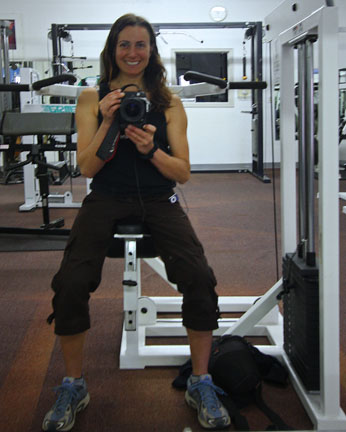
Then it’s back to the lat pull, with the second set at 80 pounds (the next increment on my machine), doing a set of 8. Then back to the military press, with the second set at 45 pounds, the next jump up, with a set of 8. Then back to the waist lat pulls, third set at 95 pounds, 6 reps, and over to the shoulder press, third set at 60 pounds, 6 reps.
I do another set at the lat pull machine, this time more traditional style, pulling the bar in front of my face to chest level, at higher weight, going from 110 to 125 (around my body weight) to 140. I alternate this exercise with the front chest pull machine, which is also a for-climbing exercise.
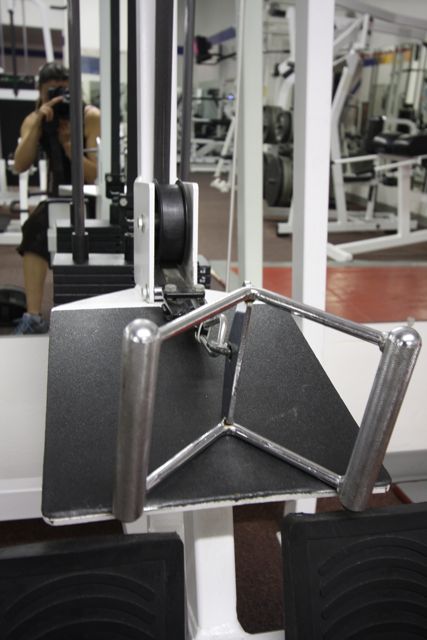
I also do rows (for-climbing), butterfly cable pulls (for-climbing), chest presses (opposite of climbing), and butterfly chest pulls and presses (opposite and for-climbing).
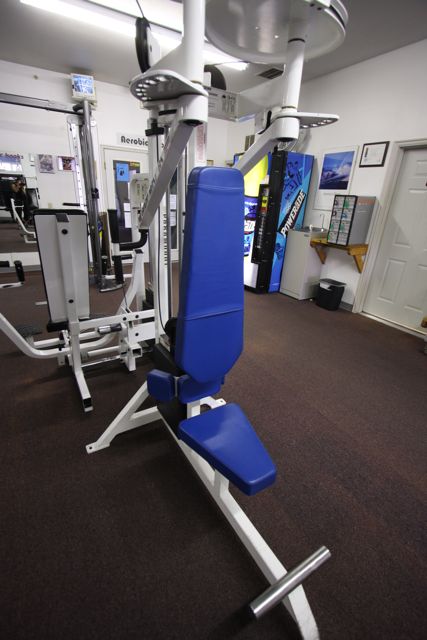
When I finish those exercises, I move over to abs and biceps, for the end of my workout.
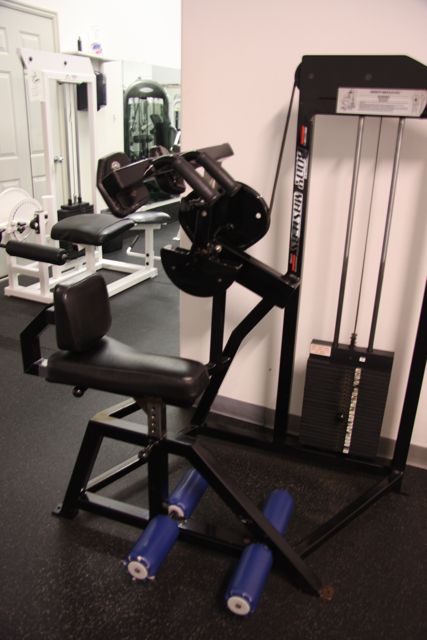
I do three different ab machines, torso twists, straight weighted crunches, and this fun crunch machine they just got at the gym 🙂 I do floor abdominal exercises at the end of my yoga sessions, at home, so I take advantage of the machines for ab workouts at the gym. I do as much ab work as possible, in general, because I have found that when I increase my core strength, it directly benefits climbing. It seems like the more I do, the better, with core strength training.
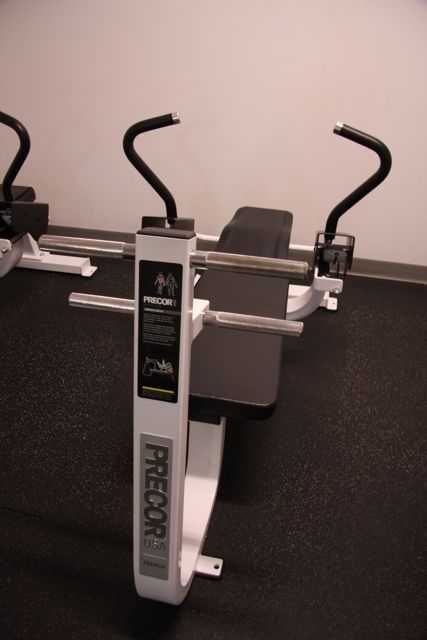
I add in bicep curls to the ab circuit, so I’m switching between four different things instead of just two, like I do with the other ones. As with all of them, I use the incremental weight and rep increases.
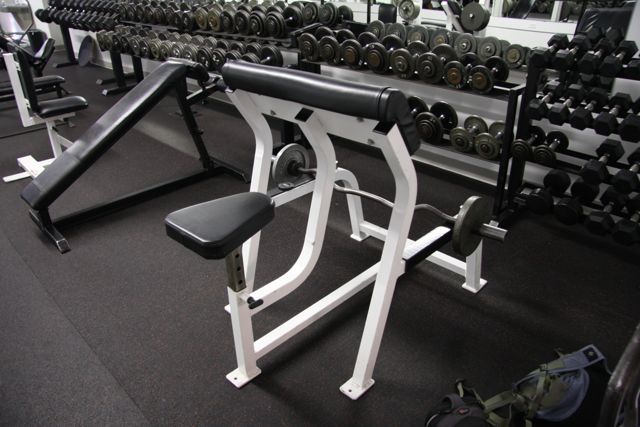
With the bicep bar, I start with a 10 pound weight on each side, and increase it by adding 2 1/2 pound weights for the second and third sets.
So generally, the weight training is a concept. Pick exercises that you think are directly related to climbing (lat pulls to waist level, normal lat pulls, rows, cable pulls, bicep curls, abdominals), and some that seem like opposing muscle groups (shoulder presses, bench presses, butterflies), and use increasing weights with sets of 3 for each exercise, starting with reps of 10,8,6 and progressing to 10,10,10 over a couple of weeks, before you go up a notch in weight and start at the higher level with the 10,8,6.
Doing this workout can take about an hour, or a little less or more, depending on if I am being ruthlessly efficient. When I am in a regular weight lifting phase, (usually during the very hot or cold seasons in Moab, when it’s good to be inside) I try to get to the gym twice a week, to make sure I’m keeping somewhat of a routine. I don’t lift much when it is the high climbing season (spring or fall), and I do change up my routine in the gym a bit at different times.
I think lifting weights is great–keeps you healthy and strong, and lets you move your body in a non-death defying way, which is definitely a bonus!








Hi Steph,
Love the blog! You might have some interest in checking out this weight training program for climbers:
http://mtnathlete.com/page.php?page_ID=22
Thanks Brendan!
Chris Dahms sent in a very thorough and useful description of super-specific lifting theory and suggestions. Thank you Chris, for this great information!
Unfortunately, it is too long for the comment box to handle, so here is one segment, and a link he provided:
“I like how you pair pushing a pulling exercises, it allows more rest between exercises and there is evidence that exhausting agonists (say for example your pecs/shoulders/triceps during presses) increases your ability to recruit antagonists for a short while after (the lats and biceps here).
Semi-pronated (hands facing each other), and totally pronated (palms down) curls are more sport specific for climbing, they target brachioradialis and brachialis which are the primary arm flexors (not the biceps interestingly enough)
Something I didn’t see you mention which I think most climbers need is direct work of the external rotation muscles (suprasprinatus, infrasprinatus, subscapularis, teres minor) as they stabilize the shoulder. Climbers tend to do a lot of work on the major internal rotators of the shoulder (lats, pecs) and I often see deficiencies in their external rotation strength inhibit their climbing progress through injury, lack of strength gains and shoulder instability.
Charles poliquin has done some extensive research on how balance between strength ratios can inhibit maximal performance in athletes, this article outlines how he took a hockey players bench press from 280 pounds to 380 pounds in 4 months, without him benching for the first 3 months and concenrating on external rotation exercises.
http://www.t-nation.com/free_online_article/sports_body_training_performance/achieving_structural_balance“
[…] Update Check out the awesome Steph Davis’ post on weight training for climbers. […]
good grief. just for kicks, i measured around the largest part of my bicep: 9 whole inches, 80% of it flab and 20% of it bone. i’d say i have the arms of an 8-year-old child, but most 8-year-olds i know are stronger than i am. i’m going to try this workout, but with about 75% of the weight knocked off (which, in some cases, will just mean moving my arms up and down all by themselves).
thank you for providing such an interesting post on weight training – it’s very informative & helpful
I hope you will try it! And yes, the weights I described was just to give an example of ranges I’m doing. I’m sure the weight I’m using is very light, for someone with more upper body strength, so don’t get hung up on the examples in this post. Like I said, it’s more about a concept, and just getting into the weight room. Definitely, do whatever feels good to you…start really light, and ease into things. It’s all about progression, and starting somewhere, wherever that is.
🙂 S
Great article! I’m happy to see I use the same machines at my gym. I’m going to alter my sequencing a little though to mirror yours.
I followed the link Chris Dahms suggested to you they seem sound and familiar (after a rotator cuff injury I had some exercises recommended to me).
[…] lesson of live) and i hope to meet you one day. take care raoul. Ciao Raoul! I have written about the way I lift weights in an earlier post in case you want to check it out, and I am glad to get your letter because I just started into the […]
[…] only three miles from my house, the Tombstone was a perfect addition to climbing on my wall and weight lifting. I really love climbing by myself, whether it’s free soloing or roped mini-traxion on a hard […]
[…] along with rotation for diversity is always good. I have a few blog posts on this site about weight training and fingerboard workouts that could give you a place to […]
[…] I was recovering from the ACL surgery, I also used the weight room a lot, every day, in fact. I did tons of pullups and also did fingerboard workouts, since the only […]
[…] Rae, I used to lift weights in the winter, but I switched to more finger-specfic training with a hangboard, campus board and systems. For me, […]
[…] If you do find yourself with access to a weight room (sometimes easier to find than a climbing gym), here are some more ideas about where to start with weight lifting. […]
If you are a fitness enthusiast, you may already have purchased some weights, resistance bands, exercise machines and some exercise routines to ensure you remain fit all the time. Still, if you are not getting desired result with the tools and machines you have, you should consider having a climber exercise machine which can help you get fitter and stronger in a real quick time. Yes, spending just around 10 minutes a day, 3-4 days a week with a perfect climber exercise machine can give you real improvement in your body structure and overall body strength.
https://bestbrandshq.com/best-climber-exercise-machine-review/